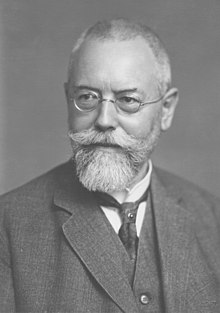August Köhler (optician)
August Karl Johann Valentin Köhler (born March 4, 1866 in Darmstadt ; † March 12, 1948 in Jena ) was a German professor and employee at Zeiss in Jena. He is best known for the development of Köhler illumination in microscopy , which revolutionized the construction of microscopes. Köhler was a co-developer of the ultraviolet microscope and was the first to recognize the importance of autofluorescence in microscopy. In 1908 he presented a luminescence microscope to the public for the first time.
childhood and education
Köhler was born in Darmstadt in 1866 , where he attended Ludwig-Georgs-Gymnasium until 1884 . He studied at the Technical University in Darmstadt, as well as at the Ruprecht-Karls-University in Heidelberg and the Justus-Liebig-University in Gießen .
Teaching and academic career
In 1888 he completed his studies and subsequently taught at grammar schools in Darmstadt and Bingen before returning to the university. He began his academic career with Professor Johann Wilhelm Spengel (1852–1921) at the Zoological Institute of the University of Giessen. The aim of his doctoral thesis was the taxonomy of limpets , a task that depended heavily on microscopic imaging and led Koehler to improve the quality of his photomicrographic images. The result of this work was published in 1893.
After earning his doctorate at the University of Giessen in 1893, Köhler worked for several years as a high school teacher in Bingen. In 1900 Siegfried Czapski brought him to Zeiss in Jena. He stayed at Zeiss as a physicist for 45 years and was involved in the development of a modern design for light microscopes. From 1922 until his retirement in 1945 he was also professor of microphotometry at the Friedrich Schiller University in Jena .
Koehler lighting
- See also the section Koehler illumination in the article light microscope
At the time of the invention of his improved microscope illumination, Koehler was working on overcoming problems in microphotography. Microscopes were then with the aid of gas lamps , kerosene lamps , Argand lamps (, electric arc light arc ) and other exotic light sources operated (Zirkonlicht, magnesium light) with an inhomogeneous light distribution. This led to uneven lighting of the sample and made it difficult to take high quality photos.
In the course of his doctoral thesis, Köhler developed a configuration that enabled a uniformly illuminated field of view and reduced scattered light from the light source in the sample plane. This included a converging lens (collector lens ) for the lamp, which made it possible to image the light source in the aperture diaphragm plane of the condenser . At the same time, the uniform light distribution that was created at the focal length behind the converging lens, which was additionally limited by an iris diaphragm called a "luminous field diaphragm" , was imaged in the sample plane with the aid of the condenser. The process of individually adjusting these apertures to match the microscope objective used is also known colloquially as Koehler.
This illumination method is still widely used in modern microscopes and forms the basis for phase contrast microscopy , differential interference contrast microscopy and epifluorescence microscopy .
Further contributions to microscopy
When Köhler came to Zeiss in 1900, Ernst Abbe and Otto Schott had already paved the way for the improvement of microscopes through their contributions to the theory of precision optics. Köhler's expertise and lighting technology contributed to achieving the best possible resolution with Abbe's lenses.
During his time at Zeiss, he contributed to many other innovations. Together with his colleague Moritz von Rohr, he developed an ultraviolet microscope. In 1904 he observed that structures under the microscope show a luminous phenomenon when they are irradiated with UV light. He discovered grid lighting , a method that was later used to treat tumors . A suggestion by Koehler led to the development of parfocal lenses that make it possible to keep the sample in focus when an objective is changed.
Patents and publications
As an employee at Zeiss, he registered at least 25 patents in Europe and at least ten in the USA. This included projection and lighting methods for cinematographs, microscope applications as well as bright and dark field lighting. His contributions to biology include fine structure analysis of diatoms.
literature
- Hans Boegehold: Köhler, August. In: New German Biography (NDB). Volume 12, Duncker & Humblot, Berlin 1980, ISBN 3-428-00193-1 , p. 306 ( digitized version ).
Web links
- Literature by and about August Köhler in the catalog of the German National Library
Individual evidence
- ↑ Ultraviolet microscope at www.mikoskop-museum.de ( Memento of the original from May 13, 2011 in the Internet Archive ) Info: The archive link was inserted automatically and has not yet been checked. Please check the original and archive link according to the instructions and then remove this notice.
- ↑ a b c August Köhler: A new lighting method for microphotographic purposes . In: Journal for Scientific Microscopy and Microscopic Technology . tape X , no. 4 , 1893, p. 433-440 ( online at archive.org ).
- ↑ Köhler A, Loos W: The phase contrast method and its applications in microscopy . In: Natural Sciences . 29, 1941, pp. 49-61. doi : 10.1007 / BF01476460 .
- ^ Douglas B. Murphy (2001): Fundamentals of light microscopy and electronic imaging , Wiley-Liss, Inc., New York, ISBN 0-471-25391-X
| personal data | |
|---|---|
| SURNAME | Koehler, August |
| ALTERNATIVE NAMES | Koehler, August Karl Johann Valentin |
| BRIEF DESCRIPTION | German optician, professor and employee at Zeiss |
| DATE OF BIRTH | March 4, 1866 |
| PLACE OF BIRTH | Darmstadt |
| DATE OF DEATH | March 12, 1948 |
| Place of death | Jena |
